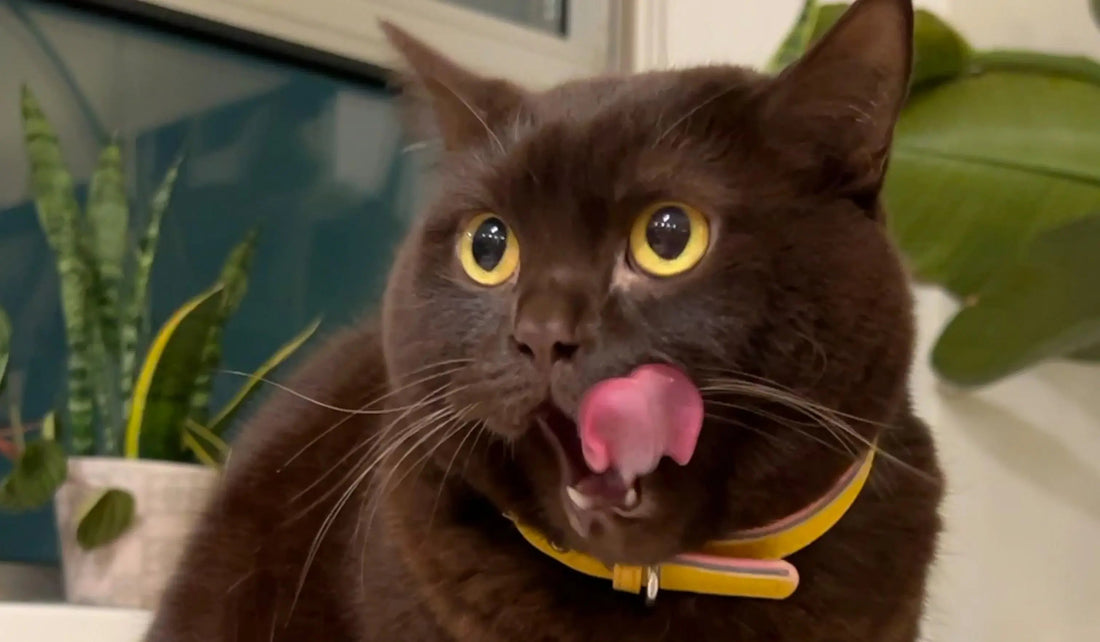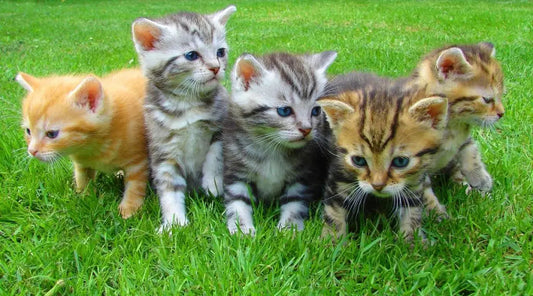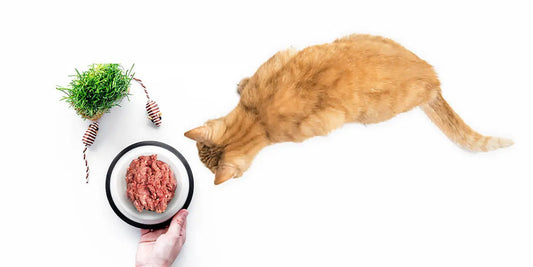
Can Cats Eat Dog Food? Understanding Pet Food Safety
Whether you’re trying to keep your cat out of the dog’s food bowl or you forgot to pack cat food while traveling with your pet, you might be wondering: Can cats eat dog food? Is it safe?
While dogs and cats have some of the same nutritional needs, they’re different species with distinct biologies—so, dog food doesn’t offer all of the nutrients cats need to thrive. While a few bites of dog food here and there won’t destroy your cat’s health, your cat should be getting the vast majority of their nutrients from foods designed specifically for cats—full stop.
In the guide below, we’re breaking down the how and why of this debate. We’ll touch on the nutritional differences between cat and dog food, the risks of relying on dog food for cats, and some potential alternatives cat parents can use in a pinch.
The Nutritional Differences Between Cat and Dog Food
Today’s pet food delivery options make it easy for pet parents to keep high-quality cat and dog food on hand—and ensure that they always have separate options for each species.
Cats and dogs do have some overlapping nutritional needs: both need to stay hydrated, get ample fats and protein, and maintain healthy levels of minerals like calcium. If you’re wondering how to keep cat hydrated, ensuring their diet includes moisture-rich foods like wet cat food or raw meals can help.
However, there are a few key nutritional differences between cat and dog food:
-
Protein – Dogs and cats both need protein for energy and growth. However, cats require more protein than dogs—so, cat food is typically higher in protein.
-
Vitamins – While dogs can break down or convert some compounds into other vitamins, cats can’t produce all of the vitamins they need to thrive. So, cat and dog foods contain unique arrays and quantities of vitamins.
-
Animal fats – Cats are obligate carnivores—they need specific acids found in animal fats to perform key biological functions. So, cat food typically contains higher quantities of animal fats.
Risks of Feeding Cats Dog Food
Is dog food good for cats? Not particularly—but what happens when you feed a cat dog food? They could potentially become deficient in key nutrients or develop health complications.
Nutritional Deficiencies
Even when consuming high-quality, fresh dog food, cats won’t get the nutrients they need to perform critical bodily functions. Food designed specifically for cats provides appropriate amounts of:
-
Arginine – Arginine is an amino acid—one of the building blocks of protein. Cats can’t synthesize it from other proteins, so they have to get it from food. Since dogs can make some arginine, their food doesn’t contain enough to meet cats’ needs.
-
Taurine – Taurine is another amino acid. While dogs can make enough taurine from other amino acids in their diets, cats can’t—they must get it from their diet via animal products. Unlike cats, dogs can produce enough taurine to meet their needs.
-
Vitamin A – Cats can’t break down plant-based carotenoids—sources of vitamin A—because they don’t have the right enzymes. So, cat food contains preformed vitamin A. Dogs do have the enzymes needed to break down carotenoids, so their food typically contains less preformed vitamin A.
-
Vitamin B3 – Cats face a similar problem with niacin (vitamin B3), which they must get from food. Since they can’t convert tryptophan, an amino acid, to niacin (while dogs can), eating dog food wouldn’t provide cats with enough B3.
-
Arachidonic acid – Cats need arachidonic acid: an essential fatty acid that plays a role in energy production. While dogs can make this fatty acid, cats cannot; dog food may not contain enough animal fat to meet this dietary need.
Potential Health Complications
Unfortunately, nutrient deficiencies don’t come without consequences. When they don’t get the proper amounts of the nutrients above, cats could develop:
-
Ammonia intoxication – Cats use arginine to metabolize nitrogen as part of their urea cycle. Without enough arginine, cats can develop ammonia (NH3) buildup—a condition that can be fatal if left untreated.
-
Heart, eye, and reproductive issues – Cats use taurine to support heart, retina, bile fluid, and reproductive functions. If they don’t get enough taurine, they could develop health issues in these areas.
-
Skin, vision, and metabolism changes – Vitamin A and B3 deficiencies can create vision, skin, and metabolic problems for cats. Arachidonic acid deficiencies can also cause metabolic issues since it’s critical for energy production in cats.
Like dogs (and humans), cats can face significant health challenges when they’re malnourished or deficient in certain nutrients. Eating food designed specifically for cats is the best way for pet parents to help cats meet their nutritional needs.
Can Cats Eat Dog Food in Emergency Situations?
Can dogs and cats eat the same food in a pinch? Cat parents may be able to substitute with canine vittles if they feed their pets raw dog food.
While we don’t recommend feeding cats raw dog food long-term, raw meat diets are compatible with cats’ ancestral needs, too. Since they’re exclusively carnivores, eating a meat-based diet in some fashion can help cats meet their nutritional needs.
However, raw pet foods are still specially formulated with species in mind—we recommend feeding cats raw meals designed for cats.
What to Feed a Cat If You Run Out of Cat Food
If you’re out of cat food and can’t immediately restock, there are safer alternatives than dog food. Some emergency options that provide better nutrition include:
-
Plain cooked chicken – A high-protein option that cats can digest easily. Avoid seasoning or bones.
-
Scrambled eggs – A great source of protein and essential amino acids. Cook them plain.
-
Canned fish – Tuna or salmon (in water, not oil or sauce) can work in a pinch but shouldn’t be a regular diet staple.
-
Unseasoned meat – Beef or turkey can provide necessary animal-based nutrients.
These alternatives ensure your cat gets essential nutrients without the risks of feeding them dog food. However, they should only be temporary solutions—always replenish your cat's proper food as soon as possible.
How to Prevent Your Cat from Eating Dog Food
If you have both a dog and a cat at home, keeping their meals separate is important to avoid unintentional feeding. Here are some tips to stop your cat from getting into the dog’s food:
-
Separate feeding areas – Place your dog’s bowl in a different room or on an elevated surface your cat can’t reach.
-
Scheduled meals – Instead of leaving food out all day, feed dogs and cats at specific meal times to prevent free access.
-
Pet food storage – Store dry kibble and canned food in sealed containers to keep curious felines from sneaking a taste.
-
Offer more treats – Some cats might be looking for variety. Providing species-appropriate treats can keep them satisfied and less likely to snack on dog food.
If “my cat won’t eat,” it could be due to stress, illness, or pickiness. Ensuring they have access to a high-quality, species-appropriate diet can encourage them to eat. Similarly, if “my dog won’t eat,” it may be helpful to assess their diet, feeding schedule, and any potential health issues. Implementing these strategies ensures your cat sticks to a balanced and nutritionally complete diet.
Discover Safe and Nutritious Cat Foods at Darwin's
One way to avoid running out of cat food is by subscribing to a pet food delivery service—like Darwin’s Natural Pet Products.
With over 100 million fresh meals served to pets nationwide, Darwin’s is your trusted source for raw cat and dog food. While other brands focus on longer shelf life for their food, we’re focused on giving a longer life to your pets—with foods that match their ancestral needs.
Get started with pet foods crafted from human-quality ingredients today.
Sources:
- FEDIAF. Can I Feed Dog Food to My Cat?. https://europeanpetfood.org/pet-food-facts/fact-sheets/nutrition/can-i-feed-dog-food-to-my-cat/
- FEDIAF. Nutritional Guidelines. https://europeanpetfood.org/wp-content/uploads/2022/03/Updated-Nutritional-Guidelines.pdf
- UC Davis. Role of Diet in the Health of the Feline Intestinal Tract and in Inflammatory Bowel Disease. https://ccah.vetmed.ucdavis.edu/sites/g/files/dgvnsk4586/files/inline-files/role-of-diet-feline-health-Glasgow_0.pdf


